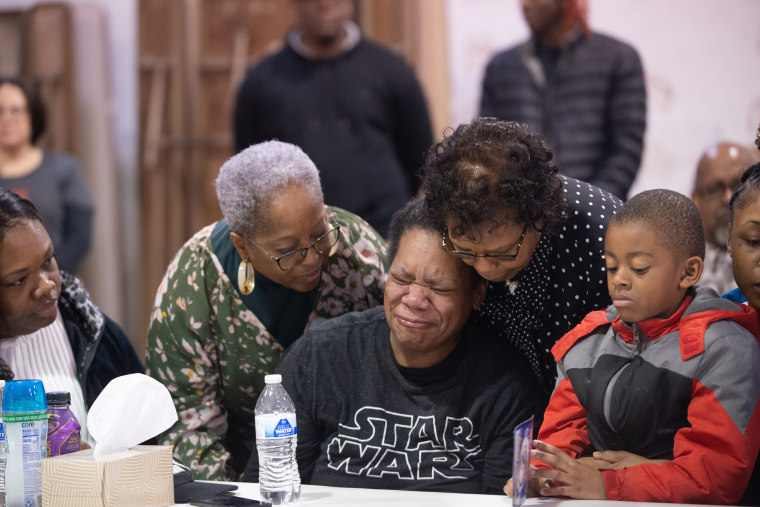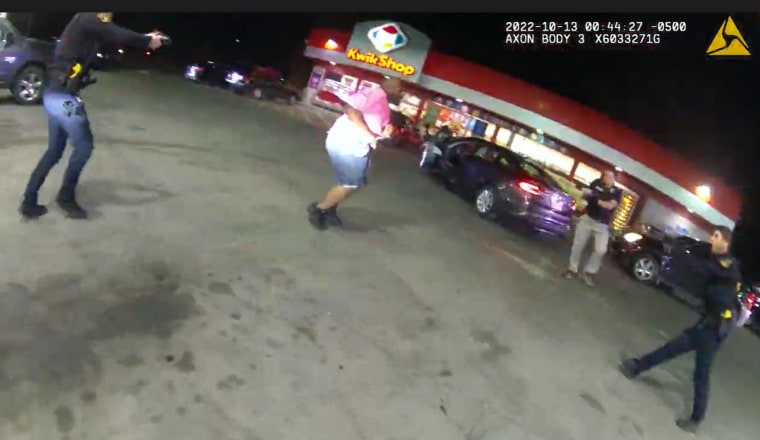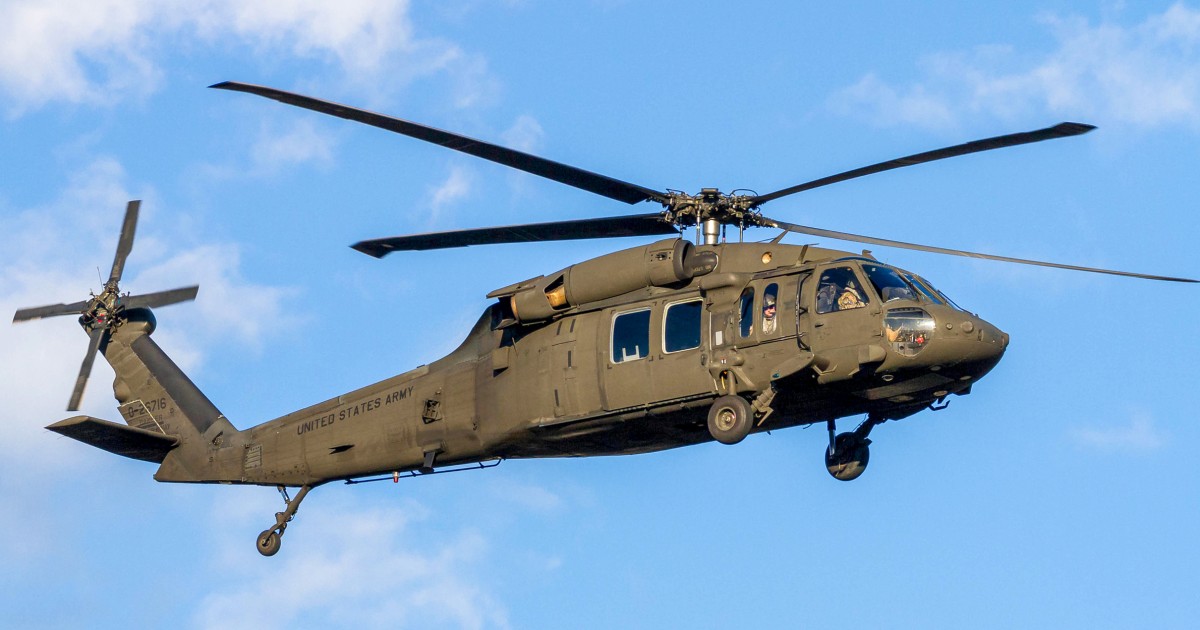The family of a Kansas man fatally shot by Topeka police in 2022 released body camera videos Friday of the encounter in an effort to dispute the police’s narrative of events.
The family of Taylor Lowery obtained the footage after a federal magistrate judge ordered the city to relinquish it as part of a wrongful death lawsuit filed in August. Lowery, 33, died at the scene after five officers discharged their weapons 34 times.
“The family has fought for over two years for transparency to expose the false narrative that Taylor was killed because he ran at the police with a knife,” said LaRonna Lassiter Saunders, a civil rights lawyer and an advocate for the family.

Da’Mabrius Duncan, the mother of Lowery’s only child who is serving as an administrator for his estate, accused Topeka police in the lawsuit of neglecting to properly train its officers, including how to de-escalate situations and take steps to prevent the risk of excessive use of force. One of the officers involved in the shooting was in such training, the suit says.
The suit had sought the release of the bodycam videos, which the city refused to do in early 2023, after the Shawnee County District Attorney’s Office announced that there would be no criminal charges in Lowery’s death and that the “use of force applied by each of the five named officers was reasonable and lawful.”
The Kansas Open Records Act allows government agencies to shield police bodycam footage from the public amid investigations. However, an agency can agree to permit certain interested parties, such as a lawyer or family, to watch footage and may charge viewing fees.
In December, U.S. Magistrate Judge Angel Mitchell ruled in favor of the family in their pursuit of obtaining the videos, rejecting the city’s argument that a protective order should keep them confidential.
“To the extent officer bodycam footage is at issue, courts tend to exclude such footage from protective orders based on the public’s strong interest in transparency of public incidents,” Mitchell wrote.
Saunders was initially able to view the bodycam footage with Ducan in the weeks after the shooting. But the family has wanted its own copy of the videos as part of the discovery process in their suit.
While officials have the right to deny disclosure of bodycam videos by saying there is a lack of “public interest,” Mitchell’s ruling is notable because it compelled a local government to hand over such video to a family, said Max Kautsch, a First Amendment lawyer in Lawrence, Kansas.

“It’s an impressive use of litigation strategy to overcome the weaknesses of the Kansas Open Records Act,” Kautsch said.
“You can’t do anything with just watching” bodycam video, he added. “You have to get the video itself because that’s what makes the point in the court of public opinion or any other place.”
Following the shooting, the Kansas Bureau of Investigation said in a news release that Lowery had “advanced toward officers” holding a knife. The bodycam videos obtained by the family shows Lowery was bending down to grab a wrench at the moment he was shot at a Kwik Shop gas station parking lot, and the knife was elsewhere on the ground out of his reach.
Through the judge’s order, the family’s lawyers were also able to determine the names of all of the officers involved in the shooting; the Shawnee County District Attorney’s Office had redacted their names in its report.
The city of Topeka declined to comment on the allegations in the suit, citing the pending litigation, but said that “law enforcement officers face dangerous and unpredictable situations every day, risking their lives and mental well-being to provide safety and protection to our community. We will continue to vigorously defend our officers in this matter.”
In a response to the family’s amended lawsuit filed with the court last month, the city denied that the officers were unjustified in the shooting, but said it “admits that after the initial round of shots, the knife remained on the ground near Lowery throughout the conclusion of the incident.” It also claimed that “none of the defendants observed the knife until after lethal force had been used.”
The question of when police are justified in their use of force came before the U.S. Supreme Court last month, as the justices examined whether deadly force can be reasonable based on the moment officers are threatened or if courts must also consider the circumstances that led up to the officers’ actions.
In Lowery’s case, the bodycam videos depict a chaotic chain of events over six minutes, first at a home he shared with his sister and then at the convenience store parking lot where he was shot.
Police responded to a call at about 12:30 a.m. after Lowery’s sister, who was barricaded in a room, told a 911 dispatcher that he had “taken a substance” and was not acting normal, and was “using a knife to try to pick a lock to acquire her car keys,” according to the family’s amended lawsuit.
In one officer’s bodycam video, a voice can be heard telling them to “kick the door down.” A juvenile eventually opens the door and can’t tell police what was happening inside, but the officers then see Lowery emerge.
At that time, the officers said, Lowery was attempting to flee the home through a back door.
“The officers caught up to Lowery outside as he stopped and started waving the knife around in what one described as a ‘fighting stance,’” the district attorney’s report said. “He also had another object, later identified as a socket wrench, in his other hand.”
The family’s suit posits that Lowery was not threatening or aggressive with the officers during the encounter at the home, and the officers at that point did not deem it necessary to fire their weapons.

Lowery is seen in an officer’s bodycam video ignoring repeated orders to “drop the knife.” He goes back inside the home and shuts the door, before the woman exits the home from another door and frantically screams that “my kids are in there.” The officers enter the home and Lowery is seen leaving with the knife in his hands.
According to police, Lowery left the property in an SUV and drove to the Kwik Shop gas station, a half-mile away, where the officers pursued him. Police said he attempted to carjack an occupied vehicle.
The incident, however, occurred in a blind spot of the convenience store’s outdoor cameras, the district attorney’s office’s report said.
The police bodycam videos show a frenzied situation in the moments before the shooting with multiple officers already on the scene and more just arriving.
The knife and wrench Lowery had been holding were on the ground as officers ordered him to “get down.” An officer can be seen in one of the videos appearing to push him. Lowery then turns around and bends down to grab the wrench by his feet. At that moment, an officer opens fire at Lowery, and others begin shooting, sending Lowery tumbling to the ground.
They command him to put his hands out and stay down as he lays on the ground, bleeding.
“We need you to put your hands out and let go of that wrench,” one of them is heard saying. Lowery no longer appears to move, and the officers handcuff him as he lies face down.
The district attorney’s office said Lowery’s autopsy showed he had been under the influence of amphetamine, methamphetamine and cocaine at the time of his death.
While multiple bullets struck Lowery, the office’s report said, “the most significant injuries consisted of three gunshot wounds to the abdomen and three gunshot wounds to the chest.”
The family’s lawsuit maintains that officers did not have to fire their weapons first, and were carrying Tasers and pepper spray that they never attempted to use.








